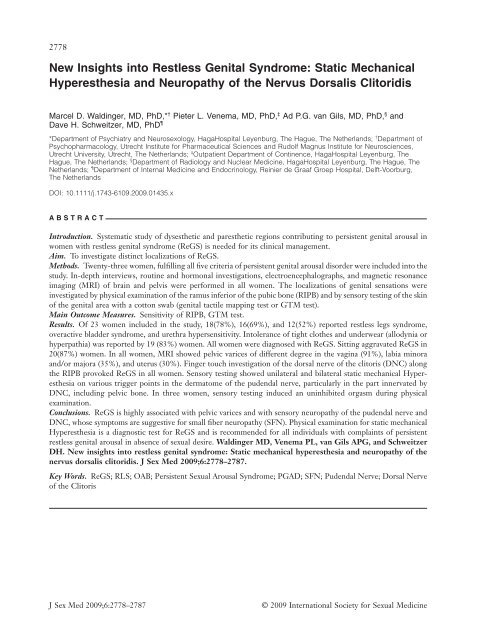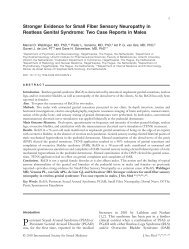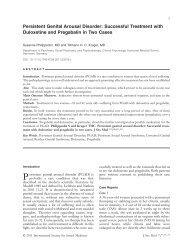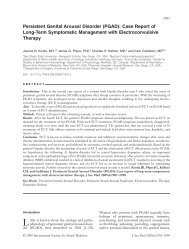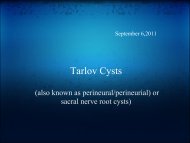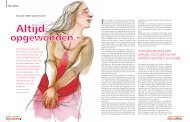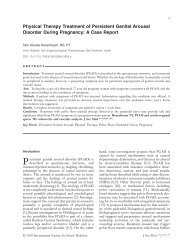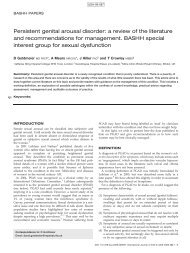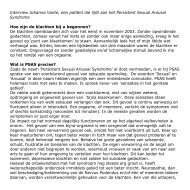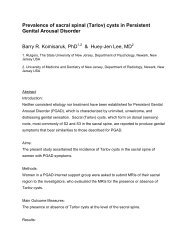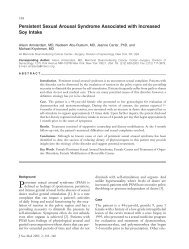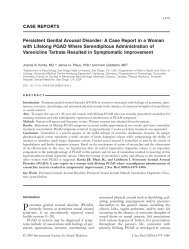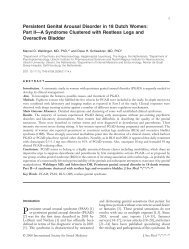New Insights into Restless Genital Syndrome - Persistent Sexual ...
New Insights into Restless Genital Syndrome - Persistent Sexual ...
New Insights into Restless Genital Syndrome - Persistent Sexual ...
- No tags were found...
You also want an ePaper? Increase the reach of your titles
YUMPU automatically turns print PDFs into web optimized ePapers that Google loves.
<strong>Restless</strong> <strong>Genital</strong> <strong>Syndrome</strong> and DNC Neuropathy 2781Table 2 Hormonal profiles of 23 women with ReGS: FSH, LH, and Progestin concentrations in premenopausal women were timed in the first phase of the menstrualcycle as were the premenopausal normal values; nonmenopausal (Non-MP; premenopausal plus perimenopausal); menopausal (MP)NormalValuesMenopausal(N = 15)Perimenopausal(N = 4)Premenopausal(N = 4)MPMean SD Median Range Mean SD Median Range Mean SD Median Range Non-MPProlactine (mU/L) 156 33 154 122–195 151 48 139 109–216 175 96 154 70–469 100–500 100–500LH (U/L) 5 3 5 3–8 34 15 34 16–50 27 9 28 22–41 4–15 >30FSH (U/L) 7 6 6 2–15 33 19 29 14–60 60 20 57 32–100 2–10 >30Testosterone (nmol/L) 1 0.3 1 0.8–2 1 0.4 1 1–2 1 0.6 1 0.1–2 0.7–3.3 0.7–3.3Estradiol (pmol/L) 651 642 569 31–1437 303 323 251 20–689 52 78 27 10–323 110–440 50–170Progestin (nmol/L) 2 0.5 2 1–2 1 1 2 1–4 1 0.5 1 1–2 0–5 0–5SD = standard deviation.women, ReGS started in the first week of norethisterontreatment and the day after ganglionstellatum blockade, respectively. The majority ofwomen reported acute or subacute onset of symptomswithout a recognizable presumed cause. Ofall women, 2 (9%) reported sexual abuse at ayoung age. None of these women associatedReGS with their history of sexual abuse. A previousepisode of depression was reported by one(4%) woman. A previous burnout syndrome andadjustment disorder were reasons for using SSRIsin the two women who reported the onset ofReGS shortly after discontinuation of theseantidepressants.The genital sensations were experienced at theclitoris, vagina, and labia in 21 (91%), 12 (52%),and eight (35%) women, respectively; seven (30%)and four (17%) women reported the sensations atthe pubic bone and in the groin, respectively; 16(69%) women reported a combination of theselocalizations. All women experienced the symptomscontinuously during the day in severe to verysevere degree, which varied in the course of weeksand months. The quality of the genital sensationswas expressed in various terms. However, in 19(83%) women, the sensations were experienced asan imminent orgasm without the genuine feelingof orgasm. Acute onset of permanent genital backgroundsensations due to tension, anxiety, anger,or annoyance was reported by all women.Sitting worsened the ReGS complaints in 20(87%) of women. Lying stretched and walkingeither diminished ReGS or did not result in complaintsin 16 (69%) and 19 (83%) of women. Otherwomen had just opposite experiences, e.g., lyingstretched and walking worsened the symptoms inseven (30%) and four (17%) of women.Of all women, 19 (83%) women reported <strong>into</strong>lerancefor various forms of clothes or tight underwear.It was reported that these clothes triggeredthe unwanted genital sensations or gave rise toinconvenient and difficult-to-describe irritanciesin the genital region. Of all women, 16 (69%)reported difficult-to-describe waves or attacks ofserious lack of energy and/or heavy fatigue.Eighteen (78%) individuals reported RLS andone (4%) woman reported restless arms; eight(35%) had restless legs since many years. An additional10 (43%) reported the onset of RLS shortlyafter the onset of genital sensations. Comparingthe 12 women previously published with those 11individuals currently reported for the first time,RLS appeared to be present in 10 (83%) and nine(82%) women, respectively.J Sex Med 2009;6:2778–2787
2782 Waldinger et al.Figure 1 Localization of points of static mechanical hyperesthesia; the points are marked with an x. The external genitaliaof the female are shown front-on in lithotomy position. The last picture shows the dermatomes of the pudendal nerve andilioinguinal nerve.Sixteen (69%) reported complaints of OAB,while seven (30%) had OAB since many years. Anadditional nine (39%) reported the start of OABshortly after the onset of the genital sensations.Comparing the 12 women previously publishedwith those individuals currently reported, OABwas present in seven (58%) and nine (82%)women, respectively. Decreased ReGS sensationsafter micturition, although only briefly, werereported by 16 (69%) of women. Conversely, 12(52%) women reported undesired urethral hypersensitivity,e.g., unwanted feelings of restlessnessand arousal in the urethra, either after voiding orduring sensations of ReGS.Routine laboratory tests, hormone profiles,EEG, and MRI brain imaging analyses were unremarkablein all women. The MRI scan of the pelvisshowed no abnormalities of the clitoris andurethra. However, pelvis MRI scan disclosed highprevalence of pelvic varices in the wall of thevagina, the labia minora and/or majora, and uterusin 21 (91%), eight (35%), and seven (30%)women. Two (9%) and one (4%) women hadvarices of the cervix and ovaric vene, respectively.A combination of varices at these locations wasfound in 16 (69%) of women. Seven (30%) womenhad varices of the legs or reported their surgicaltreatment.Figure 1 shows the findings of the GTM test.Static mechanical pressure provoked restless andpre-orgasmic genital sensations at different points.The number of trigger points varied among thewomen with a mean number of tactile hypersensitivitypoints of 5 (range 1–11). To excite the triggerpoints, only mild to moderate static mechanicalpressure was required. The trigger points werelocated on the right side, the left side, and bilaterallyfrom the vagina and clitoris in eight (35%), six(26%), and nine (39%) of women. In 11 (48%)women, trigger points were located above thepubic bone. In four (17%) women, the clitoris wasthe sole trigger point to provoke ReGS.In three (13%) women, light static mechanicalpressure elicited an uninhibited intense andrepeated orgasm during the examination at varioustrigger points. In one (4%) woman, ReGS wasJ Sex Med 2009;6:2778–2787
<strong>Restless</strong> <strong>Genital</strong> <strong>Syndrome</strong> and DNC Neuropathy 2783difficult to trigger in supine position. However, ina sitting position, combined with Valsalva, triggerpoints were inducible. In all women, pressure byfinger control (second author) alongside the RIPBelicited one or more trigger points.DiscussionThis is the second study of systematic blood analysis,MRI, and EEG examinations in a series ofwomen with complaints of persistent restless andpre-orgasmic genital sensations in the absence ofsexual desire, sexual thoughts, and fantasies. All 23women included in this study met the five diagnosticcriteria of PGAD. All women reportedvarying degrees of social withdrawal, desperatefeelings, dysthymia, agitation, or depressed mooddirectly caused by persistent unwanted genital sensations.However, despite two women with a previousburnout syndrome and adjustment disorder,none of the women was known with previouspsychiatric disorders, such as major depression,bipolar disorder, anxiety disorder, panic attacks,and/or obsessive compulsive disorder. The highprevalence of RLS (82%) and complaints of OAB(82%) in the 11 women of the current study, whohave not participated in our previous study, issimilar to their high prevalence in our previousstudy [1,2]. This, again, supports the concept thatRLS, OAB, and PGAD belong to a clustered condition,which we have called restless genital syndrome.In addition, the current study showed thatpelvic MRI disclosed a very high prevalence ofpelvic varices of different seize in all women, suggestingthat pelvic varices play an important role inthe pathogenesis of ReGS. Such an association hasalso recently been reported in a case report [14].However, in contrast to the latter case report, thepelvic varices in most of the women of the currentstudy are mild to moderate in seize. In addition,although pelvic varices have been associated withchronic pelvic pain [18], none of the women in thecurrent study complained of chronic pelvic pain.The current study demonstrated predilection ofdistribution of pelvic varices around the vagina andin the labia minora and/or majora, with relativelyless presence in the uterus, cervix, and ovaric vene.The prevalence of pelvic varices found in thecurrent series is remarkably high since 9.9%prevalence of pelvic varices has been previouslyreported in the general population [19]. In thecurrent series, we found 100% prevalence ofvarices, based on MRI criteria, which suggests thatReGS and, particularly, vagina and labia varices arestrongly associated. Interestingly, the prevalenceof varices of the legs (30%) in the current series ofwomen is not aberrant from the prevalence of 32%in the general female population [20]. The discrepancyof low and high prevalence of leg varicesand pelvic varices in women with ReGS maysuggest an independent pathogenesis of pelvicvarices in these women.In the current study, physical examination bymeans of finger touch along the RIPB and simplesensory testing with a cotton swab elicited thedisturbing genital sensations, indicating staticmechanical hypersensitivity around the genitals, atthe labia minora and/or majora, at the clitoris, andabove the pubic bone. Light pressure even evoked(repeated) orgasm in three women. This phenomenonwas experienced with much distress andembarrassment and required reassurance and briefcounseling. For this reason, presence of a skillednurse during physical examination is critical.According to our knowledge, this is the first reporton female orgasm that is triggered by pressure ofthe skin above the pubic bone and in the area nextto the vagina.The area of static mechanical hypersensitivity—bilaterallyto the labia majora andabove the pubic bone—is equivalent to the dermatomesof the pudendal and the ilioinguinalnerve. However, as it seems rather unlikely thatthe ilioinguinal nerve, a peripheral nerve originatingof the lumbar plexus (L1), mediates orgasmicfeelings, we suggest that the area of trigger pointslocated above the public bone belongs to a variantexpression of the dermatome of the pudendalnerve.The pudendal nerve originates from the pudendalplexus (S2–S4) and divides <strong>into</strong> three terminalbranches [21,22]. In the upper half of the pudendal(Alcock’s) canal, it branches <strong>into</strong> the inferior rectalnerve. The inferior rectal nerve extends motor andsensory branches. Its motor branches innervate thelevator ani muscle, and its cutaneous branchesinnervate the perianal skin and labia. At the end ofthe pudendal canal, the pudendal nerve branches<strong>into</strong> two branches, the perineal nerve and thedorsal nerve of the clitoris (DNC), which ends as aterminal branch to the clitoris. The perineal nervedivides <strong>into</strong> the labial branch and two branchestoward the bulbocavernosus and the striated urethralsphincter. DNC is believed to be a purelysensory nerve, with no motor function. Bilaterally,the DNC pierces the perineal membrane at a distanceof about 2.4–3.0 cm lateral to the externalurethral meatus [21,22] and proceeds in the sulcusJ Sex Med 2009;6:2778–2787
<strong>Restless</strong> <strong>Genital</strong> <strong>Syndrome</strong> and DNC Neuropathy 2785Figure 2 Hypothesis of neurological pathogenesis of restlessgenital syndrome. GTM = genital tactile mapping.a burning, prickling, or shooting character. Inaddition, allodynia or hyperpathia (in womenwith ReGS expressed as <strong>into</strong>lerance to wear tightclothes) and cramps may occur. Sometimespatients with SFN present with late-onset RLS[37] and the sensory symptoms are usually distal.Symptoms of autonomic dysfunction may alsooccur. These may involve increased or decreasedsweating, facial flushing, sexual dysfunction, diarrhea,or constipation. Remarkably, many patientswith SFN complain of severe and disablingfatigue. In SFN, the small diameter myelinatedA-delta nerve fibers and the small diameter unmyelinatedC-fibers are mainly affected. These smallfibers carry temperature and pain sensation andare involved in autonomic functioning. Assumingthat SFN is fundamentally involved as an underlyingcause of the symptoms of ReGS, futurediagnostic research warrants electrodiagnosticinvestigations.Based on our current and previous study inwomen fulfilling the five criteria of PGAD, wehave further developed our view on ReGS(Figure 2).Sensory neuropathy of the pudendal nerve and,specifically, the DNC is probably one of the keyfeatures or ReGS. This may lead to RLS, OAB,and/or urethra hypersensitivity. It is suggested thatthe neuropathy may be caused by pelvic varicesand/or other so far unknown factors. It is speculatedthat premorbid existence of RLS, discontinuationof SSRIs, discontinuation of cannabis, anddiscontinuation of tobacco smoking, altered hormonalstatus, for example, due to menopause, theuse of norethisteron and/or ganglion stellatumblockade might be risk factors for the outbreak ofReGS. All women who reported these selfpresumedcauses of ReGS also had pelvic varicesand showed static mechanical hyperesthesia.Notably, most women reported acute or subacuteonset of ReGS without any recognizable cause.The phenomenon of acute exacerbation of ReGSin relation to acute stress moments is probablymediated by acute activation of the sympatheticnervous system. In brief, we argue that ReGSis characterized by persistent unwanted restlessgenital sensations of pre-orgasmic and orgasmicnature, with the obligatory presence of neuropathyof the DNC and/or pudendal nerve, with at leastone of the symptoms of RLS, OAB, and urethralhypersensitivity, in the absence of concurrentsexual desire, thoughts, or fantasies. It is furthermoreassumed that pudendal sensory neuropathyin women with ReGS is an SFN, with involvementof small diameter A-delta and unmyelinated Cnerve fibers. This may explain the sensationsof paresthesias, dysesthesias, clothes <strong>into</strong>lerance(allodynia), association with RLS and the difficultto-explainwaves of extreme fatigue and loss ofenergy during the day. ReGS sensations are notconfined to the genitals. They are also experiencedabove the pubic bone.The evidence for a few parts of our view is notyet complete. Particularly, the idea that pelvicvarices are causally related to the occurrence ofpudendal and DNC neuropathy needs furtherresearch. Our group is currently investigating this.Another limitation of the current study is the lackof a control group. It is of particular importance toget more information on the prevalence of pelvicvarices on MRI in aged-matched women with nocomplaints of unwanted genital sensations. This iscurrently also investigated by our group. However,our finding of a 100% presence of pelvic variceswas not a coincidence and suggests a causal relationshipbetween this anatomical feature andsymptoms of pudendal and DNC neuropathy.These speculations need further confirmation bymeans of electrophysiological investigations. Currently,we are also investigating this issue.Finally, the findings of our current study raisesome questions on the description of the first criterionof the five criteria of PGAD. For a betterdescription of ReGS, we suggest some additions tothe first criterion. For ReGS, the current criterionof “involuntary genital and clitoral arousal thatpersists for an extended period of time (hours,days, months)” would be more appropriate as“involuntary unilateral or bilateral genital, clitoral,and/or pelvic bone arousal and restlessness thatJ Sex Med 2009;6:2778–2787
2786 Waldinger et al.persists for an extended period of time (days,months, years)”.ConclusionThe current study showed that women withReGS, irrespective of the self-presumed cause(discontinuation of SSRI or menopause), have oneor more points of static mechanical hyperesthesiaabove the pubic bone, at the clitoris, at the labia,and around the vagina. The points of hyperesthesiaare located in the pudendal dermatome, andparticularly in the area innervated by the DNC. Itis suggested that ReGS is a physical disordercaused by sensory neuropathy, e.g., an SFN, ofeither the DNC and/or other branches of thepudendal nerve. It is speculated that this neuropathygives rise to either RLS, OAB, hypersensitivityof the urethra, and clothes <strong>into</strong>lerance. Whetherthis sensory neuropathy is induced by pelvicvarices or other factors needs further investigation.Notably, RLS in women with ReGS mainly manifestsduring the day and hardly at night. We recommendphysical examination of the RIPB andsensory testing for static mechanical hyperesthesiaas diagnostic tests for the diagnosis of ReGS inall women who complain of persistent unwantedgenital arousal in the absence of sexual desire.AcknowledgmentThe authors are grateful to Mrs. Janny de Jonge, urologicnurse in continence, for her superb assistance andher warm support to the women who participated in thisstudy.Corresponding Author: Marcel D. Waldinger, MD,PhD, Department of Psychiatry and Neurosexology,HagaHospital Leyenburg, Leyweg 275, The Hague2545 CH, The Netherlands. Tel: +31-70-210-2086;Fax: +31-70-210-4902; E-mail: md@waldinger.demon.nlConflict of Interest: None.Statement of AuthorshipCategory 1(a) Conception and DesignMarcel D. Waldinger(b) Acquisition of DataMarcel D. Waldinger; Pieter L. Venema; Ad P.G.van Gils(c) Analysis and Interpretation of DataMarcel D. Waldinger; Pieter L. Venema; Ad P.G.van Gils; Dave H. SchweitzerCategory 2(a) Drafting the ArticleMarcel D. Waldinger(b) Revising It for Intellectual ContentMarcel D. Waldinger; Dave H. SchweitzerCategory 3(a) Final Approval of the Completed ArticleMarcel D. Waldinger; Pieter L. Venema; Ad P.G.van Gils; Dave H. SchweitzerReferences1 Waldinger MD, van Gils APG, Ottervanger HP,Vandenbroucke WVA, Tavy DLJ. <strong>Persistent</strong> genitalarousal disorder in 18 Dutch women: Part 1. MRI,EEG and transvaginal ultrasonography investigations.J Sex Med 2009;6:474–81.2 Waldinger MD, Schweitzer DH. <strong>Persistent</strong> genitalarousal disorder in 18 Dutch women: Part II. Asyndrome clustered with restless legs and overactivebladder. J Sex Med 2009;6:482–97.3 Basson R, Leiblum S, Brotto L, Derogatis L, FourcroyJ, Fugl-Myer K, Graziottin A, Heiman JR,Laan E, Meston C, van Lankveld J, Weijmar SchultzW. Definitions of women’s sexual dysfunctionsreconsidered: Advocating expansion and revision.J Psychosom Obstet Gynaecol 2003;24:221–9.4 Leiblum SR, Nathan SG. <strong>Persistent</strong> sexual arousalsyndrome: A newly discovered pattern of femalesexuality. J Sex Marital Ther 2001;27:365–80.5 Goldmeier D, Leiblum SR. <strong>Persistent</strong> genitalarousal in women—A new syndrome entity. Int JSTD AIDS 2006;17:215–6.6 Riley A. Premenstrual hypersexuality. J Sex MaritalTher 1994;9:87–93.7 Hallam-Jones R, Wylie K. Case report. Traditionaldance—A treatment for sexual arousal problems?Sex Relat Ther 2001;16:377–80.8 Amsterdam A, Abu-Rustum N, Carter J, KrychmanM. <strong>Persistent</strong> sexual arousal syndrome associatedwith increased soy intake. J Sex Med 2005;2:338–40.9 Goldstein I, Johnson JA. <strong>Persistent</strong> sexual arousalsyndrome and clitoral priapism. In: Goldstein I,Meston C, Davis S, Traish S, eds. Women’s sexualdysfunction and dysfunction: Study, diagnosis andtreatment. London: Taylor & Francis; 2005:674–85.10 Wylie K, Levin R, Hallam-Jones R, Goddard A.Sleep exacerbation of persistent sexual arousalsyndrome in a postmenopausal woman. J Sex Med2006;3:296–302.11 Yero SA, McKinney T, Petrides G, Goldstein I,Kellner CH. Successful use of electroconvulsivetherapy in 2 cases of persistent sexual arousal syndromeand bipolar disorder. J ECT 2006;22:274–5.12 Bell C, Richardson D, Goldmeier D, Crowley T,Kocsis A, Hill S. <strong>Persistent</strong> sexual arousal in awoman with associated cardiac defects and raisedJ Sex Med 2009;6:2778–2787
<strong>Restless</strong> <strong>Genital</strong> <strong>Syndrome</strong> and DNC Neuropathy 2787atrial natriuretic peptide. Int J STD AIDS 2007;18:130–1.13 Mahoney S, Zarate C. <strong>Persistent</strong> sexual arousal syndrome:A case report and review of the literature.J Sex Marital Ther 2007;33:65–71.14 Thorne C, Stuckey B. Pelvic congestion syndromepresenting as persistent genital arousal: A casereport. J Sex Med 2008;5:504–8.15 Goldmeier D, Leiblum S. Interaction of organic andpsychological factors in persistent genital arousaldisorder in women: A report of six cases. Int J STDAIDS 2008;19:488–90.16 Korda JB, Pfaus JG, Goldstein I. <strong>Persistent</strong> genitalarousal disorder: A case report in a woman withlifelong PGAD where serendipitous administrationof varenicline tartrate resulted in symptomaticimprovement. J Sex Med 2009;6:1479–86.17 Walters AS. International <strong>Restless</strong> Legs <strong>Syndrome</strong>Study Group. Toward a better definition of therestless legs syndrome. Mov Disord 1995;10:634–42.18 Beard RW, Highman JH, Pearce S, Reginald PW.Diagnosis of pelvic varicosities in women withchronic pelvic pain. Lancet 1984;2:946–9.19 Belenky A, Bartal G, Atar E, Cohen M, Bachar GN.Ovarian varices in healthy female kidney donors:Incidence, morbidity, and clinical outcome. AJR AmJ Roentgenol 2002;179:625–7.20 Evans CJ, Fowkes FGR, Ruckley CV, Lee AJ.Prevalence of varicose veins and chronic venousinsufficiency in men and women in the generalpopulation: Edinburgh vein study. J EpidemiolCommunity Health 1999;53:149–53.21 Vaze A, Goldman H, Jones JS, Rackley R, VasavadaS, Gustafson KJ. Determining the course of thedorsal nerve of the clitoris. Urology 2008;72:1040–3.22 Sedy J, Nanka O, Walro JM, Jarolim L. Sulcus nervidorsalis penis/clitoridis: Anatomic structure andclinical significance. Eur Urol 2006;50:1079–85.23 Ekbom K. <strong>Restless</strong> legs. Acta Med Scand 1945;158(suppl):122–3.24 Rutkove SB, Matheson JK, Logigian EL. <strong>Restless</strong>legs syndrome in patients with polyneuropathy.Muscle Nerve 1996;19:670–2.25 Gemignani F, Marbini A, Di Giovanni G, Salih S,Terzano MG. Charcot-Marie-Tooth disease type 2with restless legs syndrome. Neurology 1999;52:1064–6.26 Salvi F, Montagna P, Pasmati R, Rubboli G,Cirignotta F, Veilleux M, Lugaresi E, Tassinari CA.<strong>Restless</strong> legs syndrome and nocturnal myoclonus:Initial clinical manifestations of familial amyloidpolyneuropathy. J Neurol Neurosurg Psychiatry1990;53:522–5.27 Ondo W, Jankovic J. <strong>Restless</strong> legs syndrome: Clinicoetiologiccorrelates. Neurology 1996;47:1435–41.28 Iannaccone S, Zucconi M, Marchettini P, Ferini-Stambi L, Nemi R, Quattrini A, Palazzi S,Lacerenza M, Formaglio F, Smirne S. Evidence ofperipheral neuropathy in primary restless legs syndrome.Mov Disord 1995;10:2–9.29 Stiasny-Kolster K, Magerl W, Oertel WH, MollerJC, Treede RD. Static mechanical hyperalgesiawithout dynamic tactile allodynia in patients withrestless legs syndrome. Brain 2004;127:773–82.30 Zikel OM, Davis DH, Auger RG, Cherry KJ.Venous varix causing median neuropathy. J Neurosurg1997;87:130.31 Maser T, Scheiber-Nogueira MC, Nogueira TS,Doll A, Jahn C, Beaujeux R. Pudendal nerve compressionby pelvic varices. J Neurol Neurosurg Psychiatry2006;77:88.32 Gorson KC, Ropper AH. Idiopathic distal small fiberneuropathy. Acta Neurol Scand 1995;92:376–82.33 Stewart JD, Low PA, Fealy RD. Distal small fiberneuropathy: Results of tests of sweating and autonomiccardiovascular reflexes. Muscle Nerve 1992;15:661–5.34 Jamal GA, Hansen S, Weir AI, Ballantyne JP. Theneurophysiologic investigation of small fiber neuropathies.Muscle Nerve 1987;10:537–45.35 Al-Shekhlee A, Chelimsky T, Preston D. Review:Small-fiber neuropathy. Neurologist 2002;8:237–53.36 Lacormis D. Small-fiber neuropathy. Muscle Nerve2002;26:173–88.37 Polydefkis M, Allen RP, Hauer P, Earley CJ, GriffinJW, McArthur JC. Subclinical sensory neuropathyin late-onset restless legs syndrome. Neurology2000;55:1115–21.J Sex Med 2009;6:2778–2787


